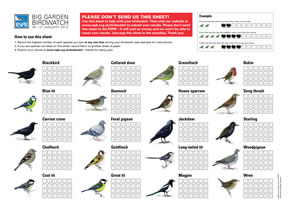Who Is Tweeting & Twittering In Your Garden?
Help reveal London’s secret singing residents
Londoners are being asked to help discover if the Capital has the UK’s widest range of bird species by taking part in the Big Garden Birdwatch.
Because of its large built-up area, London is warmer than the surrounding countryside and has a mosaic of habitats, offering a range of places that support different bird species; from weed infested brownfield sites, to manicured parks, via woodlands, waterways and variety of gardens. The Capital may have a far greater variety of species than many rural beauty spots.
This week, London’s first ever bearded tits were recorded living in reeds in Hyde Park. The birds are increasingly rare and were previously thought to be surviving mostly in areas around the eastern and southern coastlines.
This year, former members of the armed forces recovering from injury or trauma in service will be joining Chelsea Pensioners at the Royal Hospital Chelsea (RHC) to report into the Big Garden Birdwatch; co-ordinated by the gardening therapy charity Gardening Leave. They will be making bird feeders and bird boxes and putting them up around the grounds of the RHC, where the charity has a flagship project.
The Birdwatch involves looking for birds around you, recording the largest number of each species seen at any one time during an hour, then sharing the results via the RSPB’s online form, or mailing one of the widely available recording sheets.
“Putting out bird seed, fresh water, maybe some apples or dry cereal will really help birds survive the current cold spell, but it will also help draw birds into the open so you can see them more easily,” said Tim. “But be careful not to entice them into areas where they’ll be easy prey for cats or other predators.”Tim added. |
 Results from 2012 found the three most common garden birds were the starling, house sparrow and blue tit. Numbers of each of the top three birds were down compared with previous years. The survey also recorded a threefold increase in the number of goldfinches.
Results from 2012 found the three most common garden birds were the starling, house sparrow and blue tit. Numbers of each of the top three birds were down compared with previous years. The survey also recorded a threefold increase in the number of goldfinches.
Other species now commonly seen in Greater London includes more peregrine falcons than you’ll find in many of the species’ traditional territories, little egrets, ring necked parakeets, blackcaps, waxwings and even pheasants.
sample sheet
January 16, 2013
 RSPB London’s Tim Webb says:
RSPB London’s Tim Webb says: